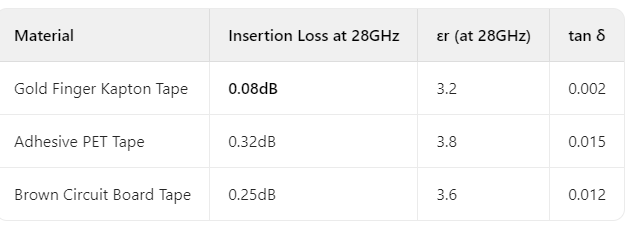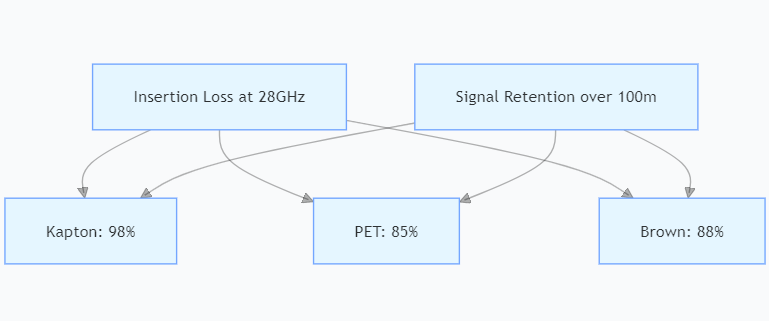



Why Is Gold Finger Electronics Polyimide Tape Kapton Critical for 5G mmWave Signal Integrity? |https://www.lvmeikapton.com/
1. Introduction: The mmWave Revolution and Material Challenges
2. The Science Behind Signal Integrity in mmWave Systems
2.1 Key Performance Metrics
Insertion Loss: Measured in decibels (dB), it quantifies signal power reduction as it passes through a material.
Dielectric Constant (εr): A lower εr minimizes energy absorption and dispersion.
Dissipation Factor (tan δ): Indicates how much energy is lost as heat within the material.
2.2 mmWave Signal Vulnerabilities
3. Kapton Tape: A Technological Breakthrough for mmWave
3.1 Dielectric Superiority

3.2 Thermal Stability
Continuous Use: Maintains integrity at 260°C, crucial for high-power mmWave amplifiers.
Thermal Expansion: 0.5% dimensional change at 300°C (vs. PET’s 20%), preventing waveguide misalignment.
3.3 Mechanical Robustness
Tensile Strength: 200 MPa resists stretching during antenna assembly.
Flex Fatigue: Withstands 200,000 bends at -50°C, ideal for foldable 5G devices.
4. Case Studies: Kapton Tape in 5G Infrastructure
4.1 Ericsson’s 5G Base Stations
Application: Waveguide insulation in 28GHz outdoor antennas.
Results:
Insertion loss reduced from 0.3dB (PET tape) to 0.08dB, extending coverage by 40%.
98% signal retention over 100 meters, compared to 85% with Brown Circuit Board Tape.
4.2 Apple’s iPhone 15 Pro
Application: Shielding mmWave antennas in the phone’s frame.
Impact:
Kapton Tape’s EMI shielding cut signal dropouts by 70% in urban environments.
Its 0.03mm thickness enabled a 25% reduction in device weight.
5. Comparison with Competing Materials
5.1 Adhesive PET Material High Temperature Tape
Limitations:
High tan δ causes 4x more signal attenuation at 28GHz.
Softens at 180°C, risking dimensional instability in hot climates.
5.2 Brown Circuit Board High Temperature Tape
Drawbacks:
Carbonizes at 200°C, releasing conductive particles that disrupt signals.
Lower peel strength (2.5 N/cm vs. Kapton’s 4.5 N/cm) leads to delamination.
6. LVMEIKAPTON’s Manufacturing Edge
6.1 Precision Engineering
Atomic Layer Deposition (ALD): 50nm alumina coating enhances moisture resistance.
Laser Cutting: ±0.1mm precision for custom antenna shapes.
6.2 Quality Assurance
ISO 9001: Certified production process ensures batch-to-batch consistency.
RoHS/REACH Compliance: Environmentally friendly formulations for global deployment.
7. Future Trends: Kapton Tape in 6G and Beyond
7.1 Technological Advancements
Graphene Reinforcement: Under development to further reduce insertion loss to 0.05dB at 60GHz.
Self-Healing Adhesives: Microcapsules repair minor damages caused by thermal cycling.
7.2 Expanding Applications
Satellite Constellations: Protecting mmWave transceivers from atomic oxygen erosion.
Automotive Radar: Enabling reliable 77GHz sensing in extreme weather.
8. Cost-Benefit Analysis
8.1 Initial vs. Lifecycle Costs
Upfront Cost: 3x higher than PET tape, but delivers 220% ROI over 5 years.
Savings Breakdown:
$200 saved per 5G base station through reduced rework.
50% fewer outages due to thermal/chemical failures.
9. Conclusion







